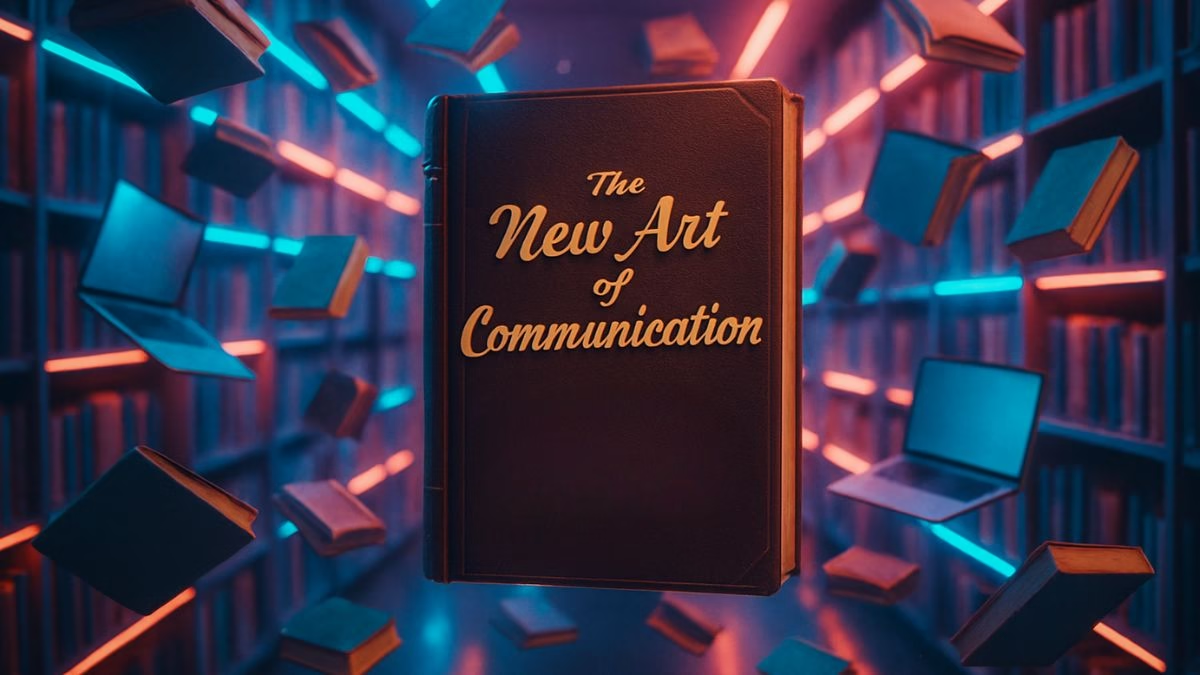Audio Article
For every English learner, the dream has always been the same: fluency. The ability to speak, write, and understand with the effortless grace of a native speaker. For decades, the path to that dream was a well-trodden, often arduous one, paved with grammar drills, vocabulary lists, and the occasional awkward conversation with a patient native speaker. Then, seemingly overnight, a new character entered the story: Artificial Intelligence.
With a tool that can instantly translate languages, correct your grammar, and even write entire essays for you, a tempting and dangerous thought can arise: “Maybe I don’t need to master English after all. Maybe the AI can just do it for me.” This is, to put it mildly, a profound misunderstanding of the moment we’re in. The rise of AI doesn’t make your English skills less important; it makes them more crucial than ever before. It signals a shift in what skills matter. The rote memorization of verb conjugations is becoming less valuable, but the ability to articulate a clear, nuanced, and precise idea has become a superpower.
Welcome to the new art of communication. It’s a discipline built on the timeless foundation of language mastery but expanded to include a new, uniquely human skill: the ability to collaborate effectively with an incredibly powerful, but literal-minded, artificial mind. This isn’t about replacing your brain with a machine; it’s about upgrading your communication toolkit. The future belongs not to those who can be replaced by AI, but to those who can leverage it to amplify their own voice, creativity, and intelligence. And that all starts with a new kind of fluency—a fluency in prompt engineering.
Your Personal Tutor: Supercharging the Core Four with AI
Before we can leap into the future, we must solidify our foundation. The “core four” skills of language learning—speaking, listening, reading, and writing—are not becoming obsolete. In fact, AI is poised to become the most patient, personalized, and persistent language tutor the world has ever known, helping you strengthen these fundamentals in ways previously unimaginable.
Speaking: The Fearless Conversation Partner
One of the biggest hurdles in learning to speak a new language is the fear of making a mistake. AI-powered chatbots and voice assistants completely eliminate this “stage fright.” You can have a conversation with an AI for hours on end about any topic you choose, from the weather in Beirut to the philosophy of Aristotle. It will never get tired, it will never judge you, and it can provide instant feedback on your pronunciation and grammar. Tools like this transform speaking practice from a high-anxiety event into a low-stakes, daily exercise, allowing you to build confidence and muscle memory at your own pace.
Listening and Reading: A World of Comprehensible Input
AI can take any text or audio file on the internet and instantly turn it into a personalized language lesson. You can use it to generate summaries of complex articles, define unfamiliar vocabulary in simple terms, or even explain cultural idioms that might otherwise be baffling. Imagine reading an article from The New York Times and being able to instantly ask your AI tutor, “What does the phrase ‘political football’ mean in this context?” or “Can you rephrase this paragraph at a simpler B1 level?” This turns the entire internet into a dynamic, interactive textbook tailored perfectly to your level.
Writing: The Dynamic Grammar Coach
For writing, AI tools are a game-changer. They go far beyond the simple spell-check of yesteryear. They can act as a sophisticated editor, suggesting ways to make your sentences more concise, your tone more professional, or your arguments more persuasive. By analyzing the corrections, you’re not just fixing an error; you’re learning the underlying principle. You’re not just being given the fish; you’re being taught how to fish. The key is to use it as a coach, not a crutch. Write the paragraph yourself first, then ask the AI for feedback. This active engagement is where the real learning happens.
The Art of the Prompt: Talking to a Genie in a Bottle
Mastering the fundamentals is essential, but it’s only half the story. The new, uniquely human skill in the age of AI is learning how to communicate with the machine. Interacting with a large language model is like having a conversation with a genie. It is astonishingly powerful, possesses a vast repository of the world’s knowledge, and can perform incredible feats. But it is also maddeningly literal. It has no common sense, no intuition, and no real understanding of your intent unless you state it with absolute clarity. A vague wish will get you a vague and often useless result. A well-crafted instruction, however, can produce magic.
This is the art of prompt engineering: the skill of designing inputs for AI models to get the most accurate, relevant, and useful outputs. It’s not about coding; it’s about communication. Let’s break down the core techniques.
The Vague vs. The Vivid: The Power of Specificity
The number one mistake people make when using AI is being too vague. A generic prompt will always yield a generic response. Specificity is the key that unlocks the AI’s power.
Let’s look at a side-by-side comparison. Imagine you’re preparing for a job interview.
- Vague Prompt: “Help me with job interview questions.”
- Generic AI Response: “Sure! Here are some common interview questions: 1. Tell me about yourself. 2. What are your strengths? 3. What are your weaknesses?…”
This is mildly helpful, but utterly generic. It’s the kind of information a five-second web search would provide. Now, let’s try a specific, well-crafted prompt.
- Specific Prompt: “I’m a marketing manager with 5 years of experience in the tech industry, specializing in social media campaigns for B2B software companies. I am interviewing for a ‘Senior Marketing Manager’ role at a startup that sells project management software. The job description emphasizes ‘data-driven decision making’ and ‘team leadership’. Please generate 10 challenging, role-specific interview questions I might be asked. For each question, provide a brief tip on what the interviewer is looking for in a strong answer.”
This prompt is a night-and-day difference. It gives the AI a persona (who you are), context (the company and role), and a clear deliverable (10 questions with tips). The AI can now provide a highly tailored and infinitely more useful response, with questions like, “Can you describe a time a social media campaign you led failed to meet its KPIs? What did you learn from the data, and how did you pivot your strategy?”
Setting the Stage: The Importance of Context and Constraints
A good prompt doesn’t just ask a question; it builds a small world for the AI to inhabit. This involves providing relevant background information (context) and setting clear rules and boundaries (constraints).
- Context: Tell the AI who it should be. Giving it a persona or role can dramatically improve the quality of its output. Start your prompt with phrases like: “Act as an expert travel agent specializing in budget travel…” or “You are a supportive but firm editor. Review the following text…”
- Constraints: Tell the AI what not to do, or define the format of the output. This is about setting guardrails. Use phrases like: “Explain this in simple terms, without using any technical jargon.” or “Write a response that is no more than 100 words.” or “Present the information in a table with three columns.”
Let’s see it in action. Imagine you want to write a professional email.
- Prompt without Constraints: “Write an email to my boss asking for a promotion.”
- Result: You’ll likely get a long, overly formal, and generic template that doesn’t sound like you at all.
Now, let’s add context and constraints.
- Prompt with Constraints: “Act as a career coach. I need to write an email to my boss, Sarah, asking for a promotion to ‘Team Lead’. My tone should be confident and professional, but not demanding. Keep the email concise, under 200 words. Mention my successful completion of the ‘Project Phoenix’ initiative and my desire to take on more leadership responsibilities. Do not mention salary at this stage.”
The result will be a well-structured, appropriately toned, and personalized draft that is 90% of the way there. You’ve constrained the length, defined the tone, provided the key information to include, and explicitly stated what to exclude. You’ve moved from a generic request to a precise act of co-creation.
The Dance of Dialogue: Iteration is Everything
The final and most important technique is to think of your interaction with AI not as a single command, but as a conversation. Your first prompt is rarely your last. The real magic happens through iteration—the process of refining and building upon the AI’s responses in a back-and-forth dialogue.
Think of the AI’s first response as a rough draft. Your job is to be the director.
- “That’s a good start, but can you make the tone more enthusiastic?”
- “I like point number 3. Can you expand on that and provide a real-world example?”
- “Let’s try a different approach. Re-write the previous response, but this time from the perspective of a skeptical investor.”
- “Combine the best ideas from your first two responses into a single, coherent paragraph.”
This iterative process is where your critical thinking and language skills truly shine. The AI provides the raw material—the clay—but you are the sculptor, shaping it with each successive prompt until it perfectly matches the vision in your mind.
The Final Polish: You are the Editor-in-Chief
This leads us to the most crucial point of all. Even with the most sophisticated prompt engineering, the AI’s output is never the final product. It is a draft. It is a starting point. It lacks a soul, a unique voice, and a human perspective. The final, and most valuable, step in this new communication process is human editing and synthesis.
An AI might write a grammatically perfect paragraph, but it can’t know the inside joke that will make your team laugh. It can generate a dozen marketing slogans, but it doesn’t have the intuition to know which one will truly resonate with your specific audience. It can summarize a report, but it can’t infuse that summary with the wisdom of your own lived experience.
Your job is to be the editor-in-chief of the AI’s output. You must check for factual accuracy (AI models are known to “hallucinate” or make things up). You must refine the tone to match your personal style. You must weave in your own stories, your own insights, and your own perspective. The AI is a powerful instrument, but you are the musician. The goal is not to have the AI write for you, but to use it to think with.
The new art of communication is a dance between human and machine. It requires us to be better, clearer, and more precise communicators than ever before. It demands that we sharpen our foundational language skills so we can give better instructions and critically evaluate the results. And ultimately, it frees us to focus on the things machines will never have: our unique voice, our creative spark, and our human judgment.
MagTalk Discussion
Focus on Language
Vocabulary and Speaking
Let’s zoom in on some of the language from that article. When you’re learning a language, new technology can sometimes feel like a threat, but the words we use to talk about it are often powerful tools you can use in many other areas of your life. Let’s start with a big one: articulate. We said that the ability to articulate a clear idea has become a superpower. To articulate something means to express an idea or feeling fluently and coherently. It’s not just about talking; it’s about being clear, precise, and easy to understand. Someone who is articulate can take a complex idea and explain it simply. For example, “She was able to articulate her vision for the company’s future so clearly that everyone felt inspired.” The opposite is inarticulate. You might say, “He was so nervous during the presentation that he was almost inarticulate.” As an adjective, you can say, “She is a very articulate speaker.” It’s a fantastic word because it combines the idea of having a good thought with the skill of expressing it well.
Next, let’s look at the word nuanced. The article mentioned the importance of articulating a nuanced idea. A nuanced idea or argument is one that has subtle shades of meaning or distinction. It’s the opposite of a black-and-white, simplistic view. A nuanced discussion about politics, for example, would acknowledge the valid points on both sides rather than just shouting slogans. Think of it like a painting. A simple drawing might just have black lines on white paper. A nuanced painting has thousands of different shades and colors. You could say, “Her analysis of the book was very nuanced; she explored the characters’ complex motivations instead of just calling them ‘good’ or ‘bad’.” It’s a sign of sophisticated thinking to appreciate nuance.
A word that often gets confused with “nuanced” but is different is concise. We mentioned AI can help make your sentences more concise. Concise means giving a lot of information clearly and in a few words; brief but comprehensive. It’s about being efficient with your language. It’s not about being simple; it’s about being clear and to the point, without any wasted words. Ernest Hemingway was famous for his concise writing style. In a professional setting, being concise is highly valued. “Please keep your report concise; we only have ten minutes to review it.” Or, “She gave a concise summary of the meeting’s main points.” It’s about being powerful and direct.
Now, let’s talk about the word repository. We described a large language model as having a vast repository of the world’s knowledge. A repository is a place where things are stored. It’s often used for information. A library is a repository of books. A museum is a repository of historical artifacts. You can also use it more metaphorically. You could say, “My grandmother is a repository of family stories.” It’s a more formal and impressive way of saying “a storehouse” or “a collection.” For example, “The online database is a valuable repository of scientific research.”
Let’s move on to the verb leverage. The article says the future belongs to those who can leverage AI. To leverage something is to use it to maximum advantage. It comes from the word “lever,” which is a tool that helps you lift heavy objects. When you leverage something—your skills, your connections, a piece of technology—you are using it strategically to achieve a bigger result. For example, “She was able to leverage her fluency in Japanese to get a job with an international company.” Or, “We need to leverage our social media presence to attract more customers.” It’s a very common business and professional word that means more than just “use.” It implies using something wisely and strategically.
A word that describes the process of getting better with AI is iteration. The article said iteration is everything. Iteration is the repetition of a process or utterance. In the context of design, software development, or even learning, it means doing something again and again, each time making small improvements. It’s the idea of getting to a great result through a series of small steps rather than all at once. For example, “The first draft of the app was clunky, but after several iterations, it’s now very user-friendly.” You could apply it to your own learning: “My process for learning vocabulary is one of constant iteration; I review my flashcards every day, making small adjustments to my method.”
Let’s look at the word baffling. We said AI can explain cultural idioms that might be baffling. If something is baffling, it’s impossible to understand; it’s perplexing. It’s a stronger word than “confusing.” A difficult math problem might be confusing, but a magic trick where a person disappears into thin air is baffling. You could say, “His decision to quit his job right after getting a promotion was baffling to everyone.” Or, “I find modern art a bit baffling sometimes.” It’s a great word to express a deep sense of confusion.
Now for a simple but very useful word: yield. We said a vague prompt yields a generic response. To yield means to produce or provide a result, an answer, or a profit. A farm yields crops. An investment yields a return. A question yields an answer. It’s a slightly more formal way of saying “produce” or “give.” For example, “Our research has yielded some fascinating results.” Or, “Negotiations with the other company failed to yield an agreement.”
Finally, let’s talk about arduous. The article described the traditional path of language learning as arduous. Arduous means involving or requiring strenuous effort; difficult and tiring. Climbing a mountain is an arduous task. Writing a 500-page novel is an arduous process. It implies a long, hard journey. You might say, “After an arduous eight-hour hike, we finally reached the summit.” Or, “He’s preparing for the arduous task of renovating his entire house by himself.” It’s a great word to describe something that takes a lot of hard work over a period of time.
So, we have this collection of great words: articulate, nuanced, concise, repository, leverage, iteration, baffling, yield, and arduous. How can we use them to improve our speaking? A really useful speaking skill, especially in professional or academic settings, is the “Problem, Solution, Benefit” framework. It’s a simple and persuasive way to structure an argument. You first state the problem, then you propose your solution, and finally, you explain the benefit of that solution. It makes your ideas clear and easy to follow.
Let’s try to build an argument using this framework and our new words. Imagine you’re trying to convince your team to adopt a new project management software.
Problem: “Currently, our workflow is not very efficient. Finding old information is an arduous task because our files are scattered, and we don’t have a central repository for project knowledge. Frankly, the complexity is baffling to new team members.”
Solution: “I propose we leverage this new software. It will require some initial training, but through a process of iteration and feedback, we can tailor it to our exact needs.”
Benefit: “The main benefit is clarity. It will allow us to communicate in a more concise and articulate way about our project goals. Better communication will yield better results and allow us to focus on more nuanced, strategic thinking instead of just trying to find information.”
See how that works? Problem, Solution, Benefit. It’s a powerful little recipe for making a persuasive point.
Here is your speaking challenge. Think of something you’d like to improve, either at your work, in your studies, or even in your home life. It could be a process, a system, or a way of communicating. I want you to prepare a short, 60-second pitch using the “Problem, Solution, Benefit” framework. Your goal is to use at least three of the vocabulary words we discussed today. Record yourself giving the pitch. Do you sound clear? Do you sound persuasive? This is a fantastic way to practice structuring your thoughts and using advanced vocabulary in a practical, real-world scenario.
Grammar and Writing
Welcome to the writing section. Today, we’re diving into a challenge that puts you directly in the driver’s seat of the new communication landscape. The article we explored was a guide to this new world, and now you’re going to create a guide of your own. Success in this challenge will hinge on your ability to give clear, precise instructions and to explain complex ideas simply—the very essence of good prompt engineering.
The Writing Challenge
Here is your writing prompt:
You are creating a “best practices” guide for new users of a generative AI tool at your company or university. The goal is to help your colleagues or fellow students move beyond generic prompts and get high-quality, useful results. Choose one specific, common task (e.g., brainstorming marketing slogans, summarizing a research paper, drafting a professional email, or generating code). Write a guide of 500-700 words that includes:
- A brief, engaging introduction explaining why good prompting matters for this specific task.
- A clear, side-by-side comparison of a “bad” (vague) prompt and a “good” (well-crafted) prompt for your chosen task.
- A breakdown of at least three key prompting techniques (such as providing context, setting constraints, defining a persona, or iterating), explaining how each one improves the result.
- A concluding paragraph that emphasizes the importance of human oversight and editing.
This is a technical writing challenge disguised as a friendly guide. Your primary goal is clarity. Your reader should finish your guide and feel empowered to use AI more effectively. This will require you to be a master of instructive and explanatory language.
Let’s explore some grammatical structures and writing techniques that are tailor-made for this task.
Tip 1: The Power of the Imperative
When you are writing instructions or giving direct advice, the imperative mood is your most powerful tool. The imperative is simply the base form of the verb used to give a command or instruction. “Close the door.” “Be specific.” “Provide context.” It’s direct, clear, and concise. Your guide should be full of them.
However, just using a string of commands can sound bossy or dry. The art is to soften them with polite language or embed them in more explanatory sentences.
- Too Dry: “Be specific. Provide context. Set constraints.”
- More Engaging: “Try to be as specific as possible in your initial request. To get an even better result, make sure you provide plenty of context about your goals. Finally, don’t forget to set clear constraints, such as the desired tone or word count.”
Grammar Deep Dive: The Imperative and Instructive Language
Vary your use of the imperative to keep the tone helpful, not demanding.
- Direct Imperative: “Use a clear persona at the start of your prompt.”
- Softened Imperative: “Consider starting your prompt with a phrase like ‘Act as an expert…'”
- Imperative with Explanation: “Provide specific details about your target audience; this helps the AI tailor its language and tone.”
- Negative Imperative (for warnings): “Do not accept the first output as the final product. Never copy and paste without fact-checking.”
Use bullet points or numbered lists in your guide to make these imperative-based instructions easy to scan and digest.
Tip 2: Explaining “Why” with Clauses of Reason and Purpose
A good guide doesn’t just tell you what to do; it tells you why you should do it. Explaining the reason behind your instructions makes them more memorable and persuasive. The best grammatical tools for this are clauses of reason and clauses of purpose.
- Clauses of Reason (explaining why): These often start with because, since, or as.
- “You should provide context because the AI has no common sense of its own.”
- “Since the AI is trained on a vast and varied dataset, setting a tone is crucial for getting a professional response.”
- Clauses of Purpose (explaining the goal): These often use the infinitive to + verb or phrases like in order to and so that.
- “To get a more creative response, you can ask the AI to think of five different approaches.”
- “Set a word count constraint in order to ensure the output is concise and focused.”
- “You need to iterate on your prompts so that you can shape the AI’s output to your exact needs.”
Grammar Deep Dive: Constructing Explanatory Sentences
Combine an imperative instruction with a clause of reason or purpose to create a perfect instructional sentence.
[Imperative Instruction] + [Clause of Reason/Purpose]
“Give the AI a clear persona so that it can adopt the appropriate tone and style for your task.”
“Be extremely specific in your request because a vague prompt will only ever yield a vague answer.”
Your guide should be filled with sentences like these. They are the building blocks of clear explanation.
Tip 3: The Language of Comparison
Your writing challenge explicitly asks for a side-by-side comparison of a “bad” prompt and a “good” prompt. To make this comparison effective, you need to use the language of contrast. This involves using specific transition words and grammatical structures to highlight the differences between the two examples.
- Comparative Adjectives: better, more specific, more useful, less generic.
- “The second prompt is more effective because it is more specific.”
- Conjunctions of Contrast: while, whereas, but.
- “While the first prompt is short and easy to write, the second prompt yields a much more useful result.”
- “The first prompt asks a generic question, whereas the second provides detailed context about the user’s goals.”
- Adverbs and Transitional Phrases: in contrast, on the other hand, however.
- “The first AI response is generic. In contrast, the second response is highly tailored to the user’s specific role.”
- “You could simply ask the AI to ‘write an email.’ On the other hand, a much better approach is to provide the key points you want to include.”
By using this language, you are not just showing two examples; you are actively guiding your reader’s attention to the specific differences that matter. You are teaching them how to see why the good prompt is good.
By combining direct, imperative instructions, explaining your reasoning with clauses of purpose and reason, and using clear comparative language, you can create a guide that is not only informative but also incredibly empowering for your reader.
Vocabulary Quiz
Let’s Discuss
The article argues that AI makes strong English skills more important. Do you agree or disagree?
Think about the “genie in a bottle” analogy. Does having a powerful tool that understands language make your own language skills more or less critical? Discuss a scenario where a person with poor communication skills might get a bad result from an AI, while a person with strong skills gets a great result, even when asking for the same thing.
What do you think is the biggest risk or downside of using AI as a language learning tutor?
Consider the potential for over-reliance. Could learners become so dependent on AI for grammar correction that they never internalize the rules? What about the lack of genuine cultural exchange that comes from speaking with a human? Discuss the potential for AI to create “fluent but shallow” speakers who are grammatically perfect but lack a deeper cultural understanding.
Prompt engineering is described as a “new art of communication.” Do you think this is a skill everyone will need in the future, like typing or using the internet?
Explore the pervasiveness of this technology. Will interacting with AI be a part of most jobs and daily tasks within the next decade? Discuss whether prompt engineering should be taught in schools. Is it a temporary technical skill or a fundamental new form of literacy?
The final step mentioned is human editing and adding a “unique voice.” What does a “unique human voice” in writing mean to you?
Think about the writers or speakers you admire. What makes their style unique? Is it their humor, their storytelling, their specific vocabulary, their emotional tone? Discuss how you can inject your own personality and perspective into an AI-generated text to make it truly your own. Share an example of how you might edit an AI’s formal sentence to make it sound more like you.
Looking beyond language learning, how might the skill of prompt engineering be useful in other areas of life?
Get creative and think about the core skill: giving clear, specific, context-rich instructions to get a desired outcome from a complex system. How could this apply to communicating with other people? Could it make you a better manager, a better collaborator, or even better at asking for what you want in your personal relationships? Discuss whether learning to talk to a machine could inadvertently teach us to be better communicators with each other.
Learn with AI
Disclaimer:
Because we believe in the importance of using AI and all other technological advances in our learning journey, we have decided to add a section called Learn with AI to add yet another perspective to our learning and see if we can learn a thing or two from AI. We mainly use Open AI, but sometimes we try other models as well. We asked AI to read what we said so far about this topic and tell us, as an expert, about other things or perspectives we might have missed and this is what we got in response.
It’s a pleasure to jump in. The article provides an excellent, practical guide to the new landscape of communication. It perfectly captures the shift from pure language mechanics to the strategic art of prompting. However, I’d like to shed some light on two slightly more advanced concepts that represent the “next level” of human-AI collaboration: “Chain-of-Thought” prompting and the emerging discipline of “Prompt Curation.”
First, let’s talk about “Chain-of-Thought” prompting. The article focused on providing clear context and constraints in a single prompt. That’s the foundational level. The next level up involves not just telling the AI what to do, but guiding it on how to think. Researchers discovered that if you ask a large language model a complex reasoning question, it might get it wrong. But if you first ask it to “think step-by-step” or “show its work,” its accuracy improves dramatically.
What does this mean for a regular user? It means for any complex task, you can add a simple instruction at the beginning of your prompt like: “First, identify the main objective. Second, break down the required components. Third, draft each component. Finally, assemble the components into a coherent whole.” You are essentially giving the AI a mental model or a reasoning framework to follow. For an English learner, this is incredibly powerful. Instead of just saying, “Write a persuasive essay,” you could say, “I want to write a persuasive essay. First, help me brainstorm three main arguments. Second, for each argument, find one supporting piece of evidence. Third, help me write an outline. Finally, let’s write the introduction.” You are breaking down the task and guiding the AI’s “thought process,” which results in a much more structured and logical output. It’s the difference between asking for a finished car and asking an engineer to help you design the engine, then the chassis, and then the body.
The second idea is what I call “Prompt Curation.” As we use these tools more, we’ll find that we often need to perform similar tasks repeatedly. A social media manager needs to generate posts every day. A student needs to summarize articles every week. A “Prompt Curator” doesn’t start from scratch every time. They build and maintain a personal library of highly effective, reusable prompts.
This is more than just a saved text file. It’s a strategic toolkit. A great prompt curator has a prompt for “writing a formal email to a new client,” another for “writing a friendly follow-up email,” and a third for “writing a delicate email to address a customer complaint.” Each of these master prompts is already filled with the best practices—it defines the tone, sets the constraints, and might even include placeholders like [Client Name] and [Project Name]. This elevates your efficiency to a whole new level. You are no longer just an AI user; you are an AI workflow designer. For a language learner, this could mean creating and saving a master prompt for “Review my writing and act as a friendly English tutor, focusing on my common mistakes with verb tenses and prepositions.” You build the perfect prompt once and then leverage it over and over. This discipline of creating, testing, refining, and organizing your best prompts is, I believe, a critical meta-skill for the future.
So, as you get comfortable with the basics of good prompting, I encourage you to explore these next frontiers: guiding the AI’s thinking process and curating your own library of powerful, reusable prompts.










0 Comments